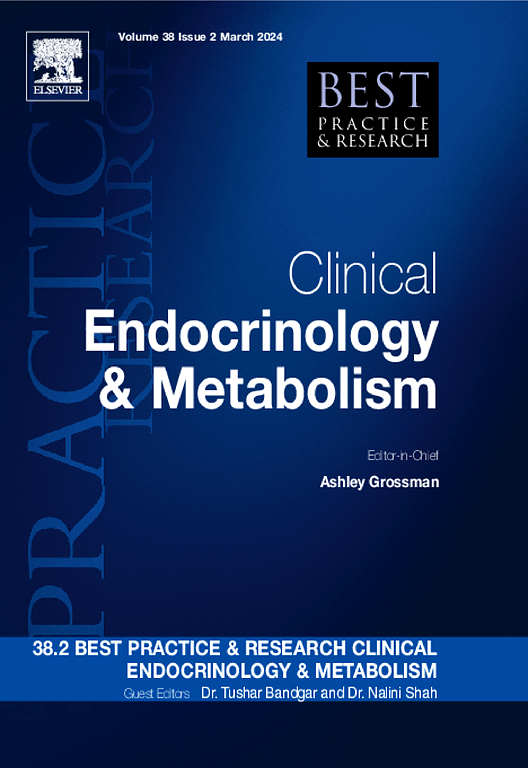关于 SDHx 致病变异携带者和患者中的嗜铬细胞瘤和副神经节瘤的初步筛查和管理的最新指南和共识声明概览
IF 6.1
1区 医学
Q1 ENDOCRINOLOGY & METABOLISM
Best practice & research. Clinical endocrinology & metabolism
Pub Date : 2025-01-01
DOI:10.1016/j.beem.2024.101938
引用次数: 0
摘要
辉铬细胞瘤和副神经节瘤(PPGLs)是一种罕见的神经内分泌肿瘤,具有很强的遗传倾向,涉及 20 多个基因,40% 的病例中发现了种系致病变体。琥珀酸脱氢酶()基因是遗传性 PPGLs 最常涉及的基因,占病例的 20%,由于其潜在的多发性、复发性和侵袭性表现,给诊断和治疗带来了独特的挑战,往往需要终生随访。在过去二十年中,生化和影像评估、管理和随访方案的进步大大改善了对成人和儿童患者的治疗。这些进步包括下一代测序、新的生化检验、集群特异性功能成像以及改进的手术和放疗技术,如立体定向手术和肽受体放射性核素治疗(PRRT)。目前已制定了国际共识指南,以规范对致病变异患者的管理,强调多学科方法和经常性的肿瘤委员会讨论。这些指南涵盖了对初始基因检测、肿瘤筛查、后续治疗以及患者和无症状携带者管理的建议,概述如下。本文章由计算机程序翻译,如有差异,请以英文原文为准。
Overview of recent guidelines and consensus statements on initial screening and management of phaeochromocytoma and paraganglioma in SDHx pathogenic variant carriers and patients
Phaeochromocytomas and paragangliomas (PPGLs) are rare neuroendocrine tumours with a strong genetic predisposition, involving over 20 genes and with germline pathogenic variants identified in 40 % of cases. The succinate dehydrogenase (SDHx) genes are the most commonly implicated in hereditary PPGLs, accounting for 20 % of cases, and present unique diagnostic and treatment challenges due to their potential for multiple, recurrent, and aggressive manifestations, often necessitating lifelong follow-up. Over the past two decades, advances in biochemical and imaging assessments, management, and follow-up protocols have significantly improved care for both adult and paediatric patients. These advances include next-generation sequencing, new biochemical tests, cluster-specific functional imaging, and improved surgical and radiotherapy techniques, such as stereotactic surgery and peptide receptor radionuclide therapy (PRRT). International consensus guidelines have been developed to standardise the management of patients with SDHx pathogenic variants, emphasising multidisciplinary approaches and frequent tumour board discussions. These guidelines, summarised below, cover recommendations for initial genetic testing, tumour screening, follow-up care, and management of patients and asymptomatic carriers.
求助全文
通过发布文献求助,成功后即可免费获取论文全文。
去求助
来源期刊
CiteScore
11.90
自引率
0.00%
发文量
77
审稿时长
6-12 weeks
期刊介绍:
Best Practice & Research Clinical Endocrinology & Metabolism is a serial publication that integrates the latest original research findings into evidence-based review articles. These articles aim to address key clinical issues related to diagnosis, treatment, and patient management.
Each issue adopts a problem-oriented approach, focusing on key questions and clearly outlining what is known while identifying areas for future research. Practical management strategies are described to facilitate application to individual patients. The series targets physicians in practice or training.

 求助内容:
求助内容: 应助结果提醒方式:
应助结果提醒方式:


